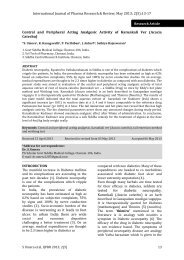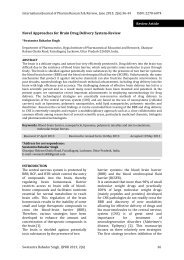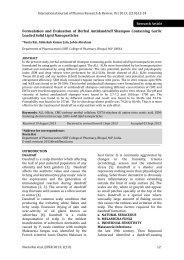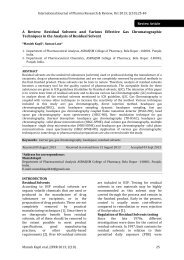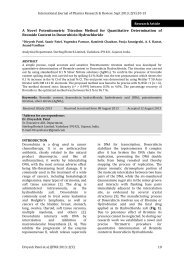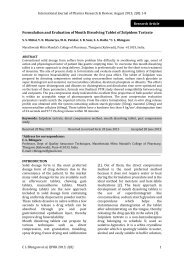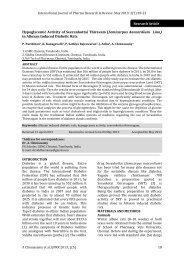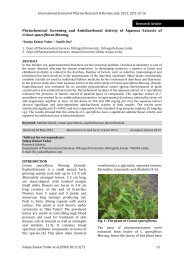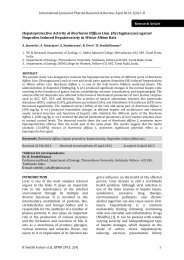International Journal of Pharma Research & Review, August 2012; 1 ...
International Journal of Pharma Research & Review, August 2012; 1 ...
International Journal of Pharma Research & Review, August 2012; 1 ...
You also want an ePaper? Increase the reach of your titles
YUMPU automatically turns print PDFs into web optimized ePapers that Google loves.
Cumulative %drug released<br />
<strong>International</strong> <strong>Journal</strong> <strong>of</strong> <strong>Pharma</strong> <strong>Research</strong> & <strong>Review</strong>, <strong>August</strong> <strong>2012</strong>; 1(4):12-20<br />
60<br />
50<br />
40<br />
30<br />
20<br />
10<br />
0<br />
0 5 10 15<br />
Time (h)<br />
F4 F5 F6<br />
Figure 1B: In vitro release pr<strong>of</strong>ile <strong>of</strong> matrix<br />
tablets containing starch as diluent<br />
To clarify the release exponent for the<br />
different batches <strong>of</strong> matrix tablets, the log<br />
value <strong>of</strong> %drug was plotted against log time.<br />
A value <strong>of</strong> n=0.45 indicates Fickian (case I)<br />
release; >0.45 but 0.89 indicates super<br />
case II type <strong>of</strong> release. Case II gradually<br />
refers to the erosion <strong>of</strong> the polymeric chain<br />
and anomalous transport (non- Fickian)<br />
refers to a combination <strong>of</strong> both diffusion<br />
and erosion controlled drug release [13].<br />
Mean dissolution time (MDI) was calculated<br />
for dissolution data using the following<br />
equation [14].<br />
Cumulative %drug released<br />
100<br />
80<br />
60<br />
40<br />
20<br />
0<br />
Cumulative %drug released<br />
Where n= release exponent and K= release<br />
rate constant.<br />
Experimental design and data analysis<br />
A 3 2 factorial design was employed to study<br />
the effect <strong>of</strong> the gum and their<br />
concentration on the release rate <strong>of</strong><br />
dicl<strong>of</strong>enac sodium matrix tablets. The levels<br />
<strong>of</strong> the two factors were selected on the basis<br />
<strong>of</strong> the preliminary studies carried out<br />
before implementing the factorial design.<br />
The percent <strong>of</strong> drug release in 4 thh (Q4), 7 thh<br />
(Q7), 10 thh (Q10), time to release 50% drug<br />
(t50%) and zero order rate constant (K0)<br />
were taken as response variables. The<br />
factors, levels and the experimental runs<br />
with their factors combination were given<br />
J Lakshmi Prasanna et.al, IJPRR <strong>2012</strong>; 1(4) 15<br />
70<br />
60<br />
50<br />
40<br />
30<br />
20<br />
10<br />
0<br />
0 5 10 15<br />
Time (h)<br />
F7 F8 F9<br />
Figure 1C: In vitro release pr<strong>of</strong>ile <strong>of</strong> matrix<br />
tablets containing MCC as diluent<br />
containing lactose as diluent<br />
0 5 10 15<br />
Time (h)<br />
F1 F2 F3<br />
Figure 1A: In vitro release pr<strong>of</strong>ile <strong>of</strong> matrix<br />
tablets<br />
containing lactose as diluent



